Starting from:
$0
Home
Presidential Papers
Swine Flu 1976 Outbreak & Vaccination Program Ford Presidential, Congressional & Medical Papers
Swine Flu 1976 Outbreak & Vaccination Program Ford Presidential, Congressional & Medical Papers
Swine Flu 1976 Outbreak & Vaccination Program Ford Presidential Papers, Congressional Documents & Medical Literatur
3,101 pages of material covering the 1976 Swine Flu outbreak and vaccination program. Including President Ford presidential papers, Congressional documents, and medical literature.
In early February 1976, two recruits stationed at Fort Dix in New Jersey, had an influenza-like illness. One of the soldiers died. Isolates of virus taken from them included A/New Jersey/76 (Hsw1n1), a strain similar to the virus believed at the time to be the cause of the 1918 flu pandemic, commonly known as swine flu. Serologic studies conducted at Fort Dix suggested that fewer than 200 soldiers had been infected and that person-to-person transmission had occurred.
At the urging of the Center for Disease Control and several well-known and respected scientists, the Ford administration moved quickly to initiate a program to inoculate every American against this perceived threat.
After approximately 20% of the U.S. population, 45 million Americans, in less than three months were vaccinated fears of the possibility of severe side effects from the vaccine emerged. Some blamed the vaccine for the deaths of thirty-two people from Guillain-Barre Syndrome (GBS), who had received the swine flu vaccine.
The Institute of Medicine (IOM) conducted a thorough scientific review in 2003 and concluded that people who received the 1976 swine influenza vaccine had an increased risk for developing GBS. Scientists have multiple theories on why this increased risk may have occurred, but the exact reason for this association remains unknown.
The CDC notes that people who got the vaccination did have an increased risk of “approximately one additional case of GBS for every 100,000 people who got the swine flu vaccine.”
The vaccination program was officially suspended on December 16, 1976.
Richard Neustadt and Harvey Fineberg wrote in their book, The Swine Flu Affair: Decision-Making on a Slippery Disease, “the swine flu program was once widely seen and now is overwhelmingly recalled as a ‘fiasco,’ a ‘disaster,’ or a ‘tragedy.’” Much of this negative impression can be attributed to the rise in cases of Guillain-Barré Syndrome (GBS) after the mass vaccination effort and the fact that the H1N1 virus was never identified outside Fort Dix, the New Jersey army base where it was first detected.
In an interview published in the Bulletin of the World Health Organization during the 2009 H1N1 pandemic, Fineberg clarified what appears to be the biggest problem in dealing with the 1976
outbreak, the “decision-making”, stating that “the fundamental strategic flaw was combining all aspects of response into a single ‘go or no-go’ decision.”
This collection includes:
President Ford Presidential Papers
1,257 pages of President Gerald Ford and the Ford administration. The papers cover the launching of the National Influenza Immunization Program (NIIP), White House meetings on the Swine Influenza Program, delays, concerns, and liability legislation and legal questions raised by the Pharmaceutical Manufacturers Association.
President Ford announced the launch of the National Swine Flu Immunization Program on March 24, 1976. He called for three actions: for Congress to appropriate $135 million to fund production of enough vaccine to inoculate the entire population of the United States; for the Department of Health, Education and Welfare (HEW) to develop plans for distributing the vaccine from September to November of that year; and for every person to receive the vaccine once it became available. "Let me state clearly at this time, no one knows exactly how serious this threat could be," President Ford said. "Nevertheless, we cannot afford to take a chance with the health of our Nation."
Congress appropriated the necessary funds and vaccine production began. Several issues arose that slowed progress, most significantly the vaccine manufacturers’ demands for the government to provide liability protection to them in case of adverse reactions to inoculation. The National Swine Flu Immunization Program of 1976 legislation was signed on August 12 answered that request and officially authorized HEW to carry out the planned inoculations.
Due to delays vaccine distribution did not begin until October. More than 45 million people received the swine flu shot in less than three months. A small number of people who were immunized developed a serious side effect, Guillain-Barré Syndrome (GBS), which led to the suspension of the program on December 16 to investigate the risk associated with the vaccine. Large scale immunization never resumed. HEW officially ended the swine flu immunization program in March 1977.
Congressional Documents
1,050 pages composed of four reports issued between 1976 and 1979 of Congressional hearings covering the 1976 National Influenza Immunization Program.
Medical Literature
795 pages of evaluation of the Swine Flu 1976 outbreak & vaccination program, published between 1981 and 2006.

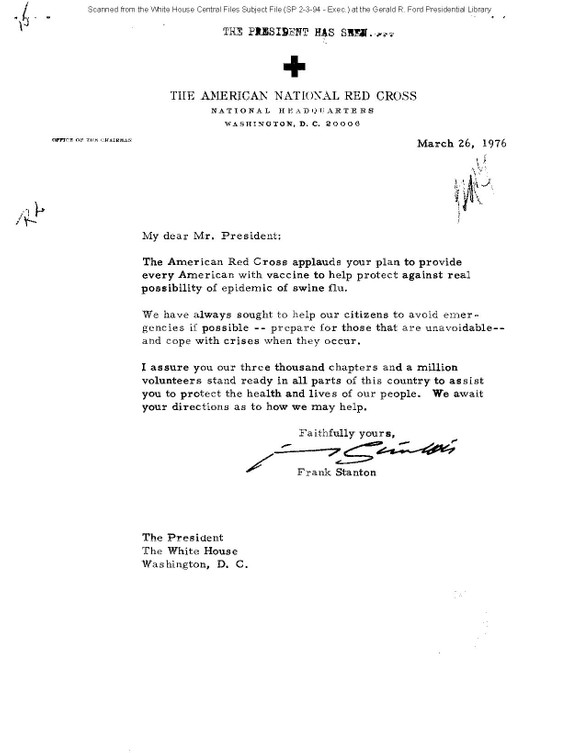
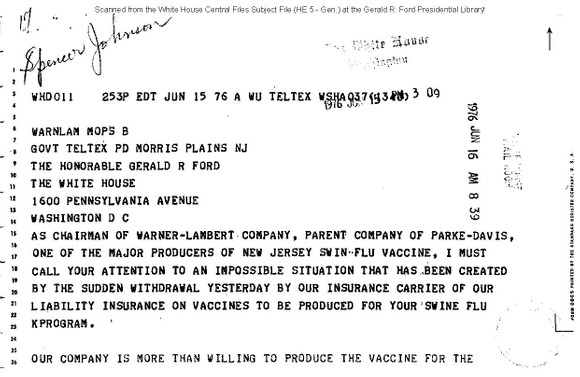
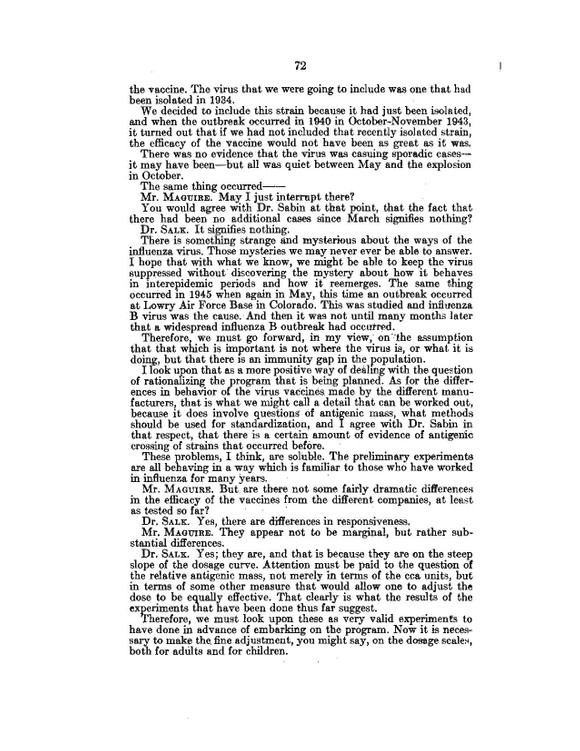
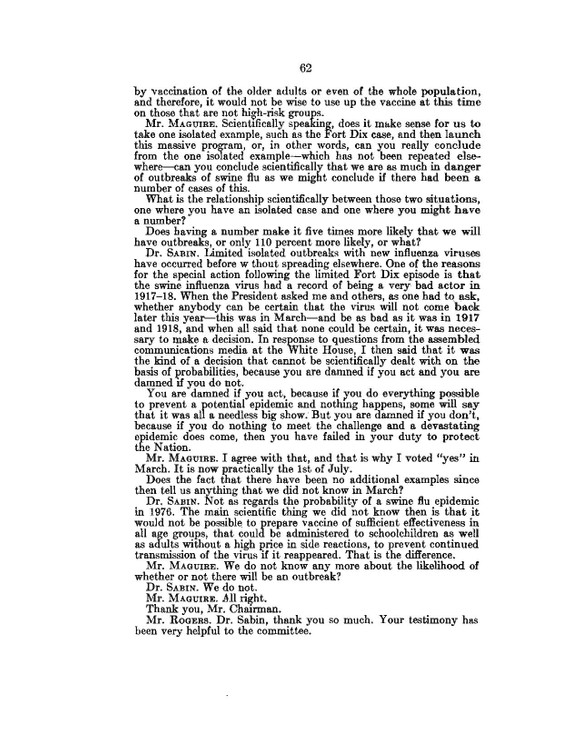
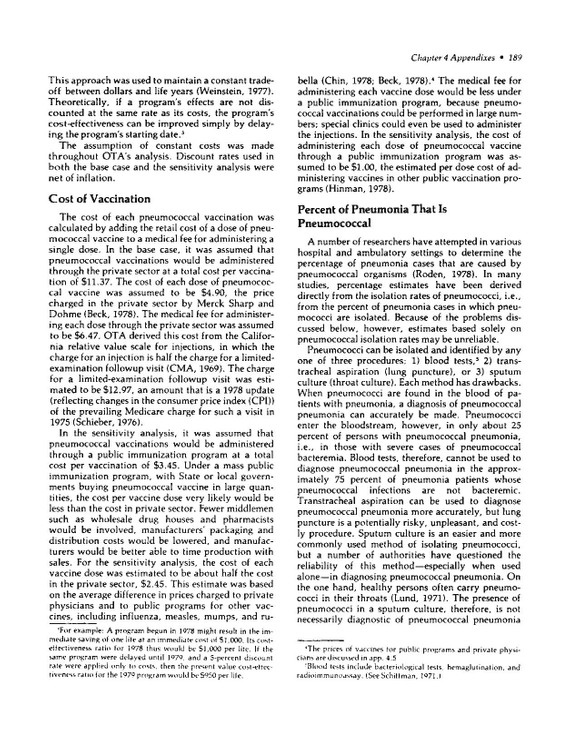

3,101 pages of material covering the 1976 Swine Flu outbreak and vaccination program. Including President Ford presidential papers, Congressional documents, and medical literature.
In early February 1976, two recruits stationed at Fort Dix in New Jersey, had an influenza-like illness. One of the soldiers died. Isolates of virus taken from them included A/New Jersey/76 (Hsw1n1), a strain similar to the virus believed at the time to be the cause of the 1918 flu pandemic, commonly known as swine flu. Serologic studies conducted at Fort Dix suggested that fewer than 200 soldiers had been infected and that person-to-person transmission had occurred.
At the urging of the Center for Disease Control and several well-known and respected scientists, the Ford administration moved quickly to initiate a program to inoculate every American against this perceived threat.
After approximately 20% of the U.S. population, 45 million Americans, in less than three months were vaccinated fears of the possibility of severe side effects from the vaccine emerged. Some blamed the vaccine for the deaths of thirty-two people from Guillain-Barre Syndrome (GBS), who had received the swine flu vaccine.
The Institute of Medicine (IOM) conducted a thorough scientific review in 2003 and concluded that people who received the 1976 swine influenza vaccine had an increased risk for developing GBS. Scientists have multiple theories on why this increased risk may have occurred, but the exact reason for this association remains unknown.
The CDC notes that people who got the vaccination did have an increased risk of “approximately one additional case of GBS for every 100,000 people who got the swine flu vaccine.”
The vaccination program was officially suspended on December 16, 1976.
Richard Neustadt and Harvey Fineberg wrote in their book, The Swine Flu Affair: Decision-Making on a Slippery Disease, “the swine flu program was once widely seen and now is overwhelmingly recalled as a ‘fiasco,’ a ‘disaster,’ or a ‘tragedy.’” Much of this negative impression can be attributed to the rise in cases of Guillain-Barré Syndrome (GBS) after the mass vaccination effort and the fact that the H1N1 virus was never identified outside Fort Dix, the New Jersey army base where it was first detected.
In an interview published in the Bulletin of the World Health Organization during the 2009 H1N1 pandemic, Fineberg clarified what appears to be the biggest problem in dealing with the 1976
outbreak, the “decision-making”, stating that “the fundamental strategic flaw was combining all aspects of response into a single ‘go or no-go’ decision.”
This collection includes:
President Ford Presidential Papers
1,257 pages of President Gerald Ford and the Ford administration. The papers cover the launching of the National Influenza Immunization Program (NIIP), White House meetings on the Swine Influenza Program, delays, concerns, and liability legislation and legal questions raised by the Pharmaceutical Manufacturers Association.
President Ford announced the launch of the National Swine Flu Immunization Program on March 24, 1976. He called for three actions: for Congress to appropriate $135 million to fund production of enough vaccine to inoculate the entire population of the United States; for the Department of Health, Education and Welfare (HEW) to develop plans for distributing the vaccine from September to November of that year; and for every person to receive the vaccine once it became available. "Let me state clearly at this time, no one knows exactly how serious this threat could be," President Ford said. "Nevertheless, we cannot afford to take a chance with the health of our Nation."
Congress appropriated the necessary funds and vaccine production began. Several issues arose that slowed progress, most significantly the vaccine manufacturers’ demands for the government to provide liability protection to them in case of adverse reactions to inoculation. The National Swine Flu Immunization Program of 1976 legislation was signed on August 12 answered that request and officially authorized HEW to carry out the planned inoculations.
Due to delays vaccine distribution did not begin until October. More than 45 million people received the swine flu shot in less than three months. A small number of people who were immunized developed a serious side effect, Guillain-Barré Syndrome (GBS), which led to the suspension of the program on December 16 to investigate the risk associated with the vaccine. Large scale immunization never resumed. HEW officially ended the swine flu immunization program in March 1977.
Congressional Documents
1,050 pages composed of four reports issued between 1976 and 1979 of Congressional hearings covering the 1976 National Influenza Immunization Program.
Medical Literature
795 pages of evaluation of the Swine Flu 1976 outbreak & vaccination program, published between 1981 and 2006.







1 file (198.9MB)



